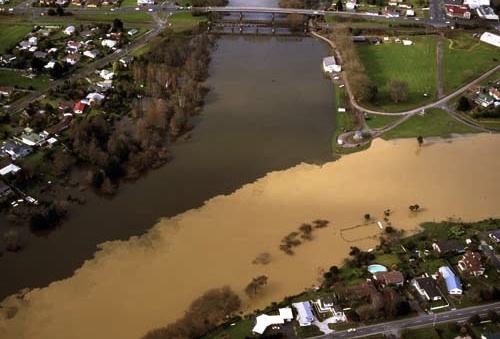Sediment
Sediment can come from soil erosion or from the decaying (decomposition) of plants and animals. Water, wind, and ice help carry these particles to rivers, streams, lakes, and aquifers. The heavier the rainfall the more likely sediment can be transported.
Sediment is a natural part of a stream, lake, or river, and the type and amount found in waterways is influenced by the geology of the surrounding area. Natural processes that contribute sediment in waterways include instream scouring of the riverbed and banks, and erosion of sediment from the surrounding catchment from natural slips and any exposed soils. Sediment can enter streams from alongside a reach or from upstream via the many smaller interconnecting streams that form a river network within a catchment area.
Soil type in the catchment can also affect the amount of suspended sediment. For example, streams in catchments with clay soils are likely to have naturally poorer water clarity than streams in sandy catchments. In slow-flowing lowland streams where sediment can be very fine, water clarity can be poor for long periods. This is due to the slow rate of flushing and the fact that very fine particles are held in suspension almost indefinitely.
While sediment movement is a natural part of a functioning freshwater ecosystem, human activities around a waterway (such as dam or road construction or land use change from native forest to pasture) can greatly increase the amount of sediment that enters the system. This can have considerable effects on water quality and the plants and animals that live there. The addition of sediment to rivers and streams above normal levels is a serious issue across many parts of New Zealand.

Image credit: John Greenwood, J. Greenwood Photography

Why is sediment a problem?
High sediment concentrations in rivers degrade ecosystem health by smothering organisms and their habitat and reducing water clarity and light penetration. While elevated suspended sediment has the greatest effect during flood events, the accumulation of sediment in the stream bed can also result in reduced clarity and elevated turbidity under low flow conditions.
What land activities increase sediment loss?
Any activity that leaves bare soil exposed, such as cultivation (ploughing, fertilising, and drilling) and vegetation clearance can increase the amount of sediment that enters nearby waterways. Waterways near agricultural and horticultural land are especially vulnerable when there is little riparian vegetation to act as a buffer for increased runoff from the land. Sediments can carry nutrients and chemical contaminants that may be washed into waterways, especially after heavy rain.
What is water clarity and when is it a problem?
Water clarity refers to the ability of light to travel through water and has two important aspects, light penetration and visual clarity. Light penetration is important as it controls the amount of light in the water needed for aquatic plants to grow. Visual clarity indicates how much suspended sediment is in the water.
Poor water clarity can have many adverse effects on stream and lake ecosystems. For example, murky water can make the water unsuitable for drinking by stock and make areas unsafe for swimming. High sediment can also harm aquatic life by clogging their gills which reduces their ability to take up oxygen. As fine particles settle in slower-moving downstream areas, the spaces between rocks and gravel are filled making the bottom habitat unsuitable for fish and other aquatic species. Poor water clarity will also affect the amount of light reaching the river bottom, potentially limiting plant growth.
How is sediment measured in water?
When a water sample is analysed for suspended sediment different techniques are applied to isolate the mineral (inorganic) and organic (volatile) forms. Sediment in a water sample is typically analysed and reported as:
Total Suspended Sediment (TSS) = Inorganic + Volatile Forms (both <0.2 mm in diameter).
Volatile Suspended Sediment (VSS)
Other measures, such as absorbance, clarity, and turbidity are measures of the optical properties of water that may be influenced by both dissolved and solid constituents. Dissolved organic carbon which comes from the breakdown of plant material in soils, also affects light penetration in water. The greater the reduction of light by suspended sediment and dissolved organic carbon, the lower the water clarity. Turbidity is influenced by the presence of ‘dissolved’ colloids that are smaller than the 2 microns used to define total suspended sediment. Therefore, the relationship between total and volatile suspended sediments, turbidity and clarity is not always simple.
For more information on water quality contaminants see Nitrogen, Phosphorus, and Microbes.